|
| |
| |
DENIS
GIFFORD'S
MONSTERS OF THE MOVIES
(1977)
|
|
Monster #24 -
The Ghoul
|
|
| |
| |
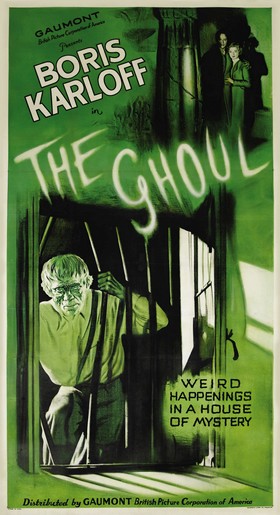 |
|

United
Kingdom, 1933
A Gaumont British Production
77 mins, black & white, 1.37:1 aspect ratio,
35mm film
Director - T. Hayes Hunter
Screenplay - Roland Pertwee, John Hastings
Turner, Rupert Downing
Original Play - Frank King, Leonard Hines
Cinematographer - GŁnther Krampf
Production Design - Alfred Junge
Makeup - Heinrich Heitfled (uncredited)
Music - Richard Wagner, arranged by Louis Levy
Editing - Ian Dalrymple
Boris
Karloff (Prof. Henry Morlant), Cedric Hardwicke
(Broughton), Ernest Thesiger (Laing), Dorothy
Hyson (Betty Harlon), Anthony Bushell (Ralph
Morlant), Ralph Richardson (Nigel Hartley)
|
|
| |
| Monsters of the Movies
served as an introduction to many "classic"
monsters in the shapes and forms of vampires and
werewolves, but there was also an entire panopticon of
very different horrors, and the Ghoul, number 24 on Denis
Gifford's alphabetic roll-call list, was one of those. |
| |
A straightforward case of nomen
est omen, the name in this case really does
say it all, and the still picture selected by
Gifford - showing Boris Karloff as the deceased
Professor Morlant who has ghoulishly returned
from the dead - immediately left an impression on
my 13-year old self at the time.
It is indeed
the classic visual from the movie (also used for
some of the theatrical posters), and it had me
make a mental note of the name Boris Karloff. Only
a few weeks later, after a happenstance purchase
of Gifford's Pictorial
History of Horror Movies, was I able to
fully grasp the actor's status and influence on
horror movies in general.
The Ghoul
has a long list of "firsts" and unique
aspects. First off, it was the only British
horror film produced in the vein of a Universal
movie, fusing a gothic England shrouded in fog
with Ancient Egyptian mystery.
|
|
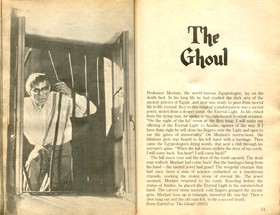
(Carousel Books / Transworld
Publishing)
|
|
| |
It was also the first British
(and third overall) movie to have the brand new
"H" (for "Horrific") certificate
slapped on by the British Board of Film Censors due to
the film’s brutal murders and a plot revolving
around premature burial.
"[When] the first true horror films
arrived in Britain (...) nobody was more horrified
than the British censor." (Gifford, 1973)
Following the release of The Mummy, Universal
took a short moment to consider what to do next with its
horror star and bridged the time by loaning out Karloff
for one movie to Gaumont British - which also marked the
first time that Karloff (who was thrilled by the
prospect) had acted in Britain since leaving for Canada
in 1909.
“I can’t tell you what the first
sight of London did to me (...) I was afraid that
memory would play tricks on me - that things would
have changed. But they hadn’t changed (...) it
seemed as if I had been gone only a day. That first
night in the hotel room, I didn’t sleep a wink.
I simply sat by an open window until dawn - filling
my eyes with the sight of it, my lungs with the odour
of it. London! That was all I had the opportunity of
doing for the next six weeks, for we started work on
the picture the very next day.” (Jacobs,
2013)
The movie was shot in March and the first half of
April 1933 at Lime Grove Studios in London's Sheperherd's
Bush, and released in the UK in August 1933 and in the US
in January 1934. The film was financially successful in
Britain but disappointingly less so in the States.
|
| |
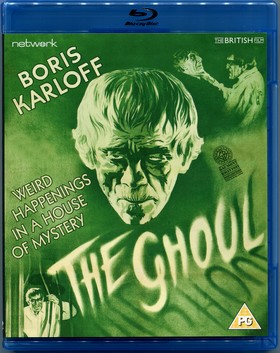
|
|
One very
special aspect of The Ghoul is the fact
that it subsequently vanished completely and was
long considered to be a lost film. But just
like its main character, it came back from its
assumed grave when horror film expert and
collector William K. Everson discovered a highly
degraded subtitled copy in 1969 in
Czechoslovakia. Although missing eight minutes of
footage (depicting two violent murder scenes), it
was thought to be the only surviving copy of the
film - until a disused and forgotten film vault
at Shepperton Studios was cleared in the early
1980s. Not only did it contain the nitrate camera
negative of the film, it was also in perfect
condition. Handed over to the custodians at the
British Film Institute, it served as the master
for new prints.
Network released The Ghoul on Blu-ray
in 2015, based on a print from the BFI archives
and digitally restored to perfect clarity both in
picture (2k HD) and sound. Extras include a
special booklet and image galleries, as well as
the by now almost obligatory commentary (in this
case by Kim Newman and Stephen Jones). Given its
history of having long been thought lost, it
certainly makes for a very special viewing.
But Karloff's experience of shooting his first
British film wasn't as positive as he might have
hoped for, as his wife revealed in a letter to
her mother.
|
|
| |
"Boris as usual doesn’t like
the story - or his part - and they’re
having an awful time with the make-up (...)
He says the make-up man doesn’t know
anything about Boris’s type of work
[and] is German besides and can’t
understand a word Boris says. So it’s
the same agony of starting a new picture even
if it’s in England.” (Jacobs,
2013)
|
|
| |
| Karloff's struggles weren't,
perhaps, all that surprising, given that he
confessed to reporters upon arriving by ocean
liner at Southampton (i.e. two days before
shooting commenced and after several days at sea)
that he hadn't even read the script yet and only
knew that he was to play a part similar to the
one in The Old Dark House (Rigby, 2015). Contemporary
critics in Britain weren't too impressed, but
when Film Weekly felt it simply
"aped Hollywood Horrors" they may have
missed the point of the movie entirely.
The Ghoul is an interesting piece of
(British) horror movie history, and it starts out
very strong for the first twenty plus minutes -
before losing its sense of direction and purpose
and turning into a rather mediocre film, saved
only by virtue of the intensely atmospheric
visuals generated by the sets and the camera
work.
|
|
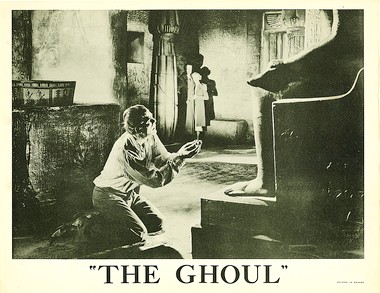
|
|
| |
| Karloff would return three years later to shoot two
more British films, both of which (The Man Who
Changed His Mind and Juggernaut) would
receive far more praise and appreciation by audiences and
critics alike than The Ghoul. |
| |
| |
| |
|
| |
| |
| |
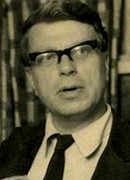 |
|
Denis Gifford on The
Ghoul
in A Pictorial History of
Horror Movies (1973)
"Boris
Karloff came home in 1933. It was a
working holiday. He called on his
delighted brothers, then made The Ghoul
(1933) at Shepherd's Bush. It was old
home week on all counts, for as Professor
Morlant, Egyptologist, he rose glowing
from his grave to seek a sacred jewel.
Cedric Hardwicke lent stolid support and
Ernest Thesiger lent his nostrils. T.
Hayes Hunter's piece of fogbound Gothic,
photographed by Gunther Krampf, was the
only British horror film in the true
Hollywoood tradition, and the first to be
"notified as horrific"."
|
|
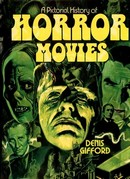 |
|
| |
|
| |
| |
| SOURCES GIFFORD
Denis (1973) A Pictorial History of Horror Movies,
Hamlyn
JACOBS Stephen
(2013) "When
Boris Karloff Came Home: The Story Behind The Ghoul 1933",
Spooky Isles, published online 27 April 2013
RIGBY Jonathan
(2015) English Gothic, 2nd edition, Signum Books
|
| |
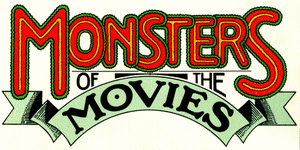
Back
to main index page
|
| |
|
| |
The illustrations presented here are
copyright material.
Their reproduction in this non-commercial review
and research context is considered to be fair use
as set out by the U.S. Copyright Act of 1976, 17
U.S.C. par. 107
and in accordance with the the Berne Convention
for the Protection of Literary and
Artistic Works.
All images from
Monsters of the Movies
(Carousel/Transworld) were scanned from my
personal copy purchased in 1977
All images of Blu-ray or DVD covers were scanned
from my personal copies
Page created 24
October 2023
Last updated 29 October 2023
(c)
2023

|
|
| |









